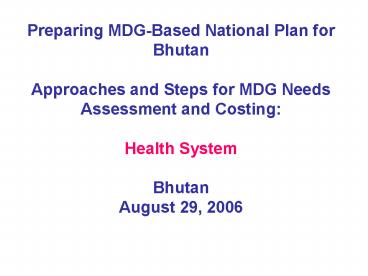MDG Needs Assessment Health Module PowerPoint PPT Presentation
1 / 16
Title: MDG Needs Assessment Health Module
1
Preparing MDG-Based National Plan for Bhutan
Approaches and Steps for MDG Needs Assessment
and Costing Health System Bhutan August 29,
2006
2
Improving Health System for Achieving MDG Health
Goals
- Health MDG goals to be achieved by 2015 from the
level of 1990 reduction of child (U5) mortality
by two-thirds, reduction of maternal mortality by
three-fourth, combating HIV, TB, Malaria and
other major diseases halting the spread and
beginning to reverse the incidence - Reaching these MDGs will require investing in a
health system that can deliver quality essential
health services to all of the population - Such a health system includes prevention and
treatment activities carried out in the
community, clinic, district, and referral
hospital. - Estimating resource needs requires not only an
assessment of individual-level inputs but a
rigorous evaluation of the costs of establishing
and maintaining a health system and the costs of
public health activities.
3
Improving Health System for Achieving MDG Health
Goals
- While it is technically possible to deliver
interventions vertically, successful scale-up and
utilization of a broad range of health
interventions requires a functioning health
system. - Estimating costs for this purpose has proven
quite difficult due to differences in the
structure of health systems in countries and the
lack of country-specific information. MP approach
to getting a rough estimate of potential health
systems costs with the main components of a
functioning health system
4
Improving Health System for Achieving MDG Health
Goals
- The main components of a functioning health
system are - Scaling up system-wide health human resources
(including clinical and administrative staff),
facilities and infrastructure. - Improving the systems ability to plan, finance,
and deliver high-quality health services. This
includes - strengthening management capacity in the system
- improving monitoring, evaluation, and quality
assurance - enhancing community demand for and access to
essential interventions - building capacity for health research and
development
5
Choosing Interventions Health System
- New infrastructure and OM of existing
infrastructure at district level - Adequate health personnel salaries
- Pre- and in-service training
- Community demand interventions
- Management systems and monitoring evaluation
- Research and development
6
Defining and Setting TargetsCoverage Targets
- Health MDGs offer no specific guidance on
coverage levels for health services. Overall aim
should be to achieve universal coverage of
essential health services (or essential health
package). - Health facilities, personnel, training, and
equipments have to be targeted to achieve the
coverage of essential health services (or
essential health package). - For achieving the health targets, the health
system interventions might need to be front
loaded.
7
Estimating Resource NeedsHuman Resources
- Need to calculate the number and cost of health
workers at all levels of the health system needed
to deliver the interventions at scale. Health
workers include (among others) - doctors
- nurses and midwives
- clinical officers
- lab technicians and technologists
- pharmacists and pharmacy technicians
- community health workers
- health managers
8
Estimating Resource NeedsHuman Resources
- Human resource cost categories include
- salary and benefits
- in-service training
- pre-service training
- retention and distribution incentives
Human resource needs should be carefully
estimated for the desired level of service
coverage
9
Estimating Resource NeedsHuman Resources
- Suggested costing methods
- Health workers per facilities
- Doctor or nurse to population ratio
- Conducting a comprehensive human resources needs
survey - Example see next slide
10
(No Transcript)
11
(No Transcript)
12
Estimating Resource NeedsInfrastructure
Number and cost of building or refurbishing
health facilities from health posts to first
level referral hospitals (including capital
costs, maintenance, and overhead). Example..
13
Estimating Resource NeedsHealth Systems
Strengthening
- Two methods
- Bottom-up costing of health system components
- Costs of managers at all levels (training and
salaries) - Quality control and audit systems
- Basic financial and accounting systems
- Health information systems (and required ICT)
- Public health functions (such as epidemiologic
surveillance) - Enhancing community demand for services (health
education and community mobilization)
14
Estimating Resource NeedsHealth Systems
Strengthening
- Overhead mark-up to direct cost of services
- Estimate a percentage of direct cost of services
as follows
15
Estimating Resource NeedsHealth Systems
Strengthening
Example If the costs of interventions,
infrastructure, salaries, and community education
equal 30 per capita annually, the additional
three health systems overhead items would add
another 37 percent of that total or 11.1 per
capita for a total health system cost of 41.1
per capita.
16
Estimating Resource NeedsAdding it All Up
Facilities/ Infrastructure
Health system strengthening
Personnel/ Training
Equip-ments
Total health system costs

